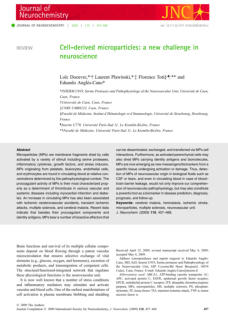Scientific papers 2009 - 2010





This document is an ensemble of articles from various
authors that present the works of Haldane and other
topics such as:
•
Decompression physiology
•
decompression methodology
•
Stategic approches
•
Environmental physiology
Their authors presented them during the Baromedical
and Environmental Physiology Group of the Norwegian
University of Science and Technology in Trondheim,
Norway, on 18–19 December 2008.
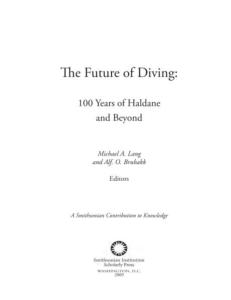

Authors: Tom McLellan, Heather Wright, Shan Rhind,
Bruce Cameron, & David Eaton.
This study compared neuroendocrine and psychomotor
responses in divers (d, n=11) and non-divers (Nd, n=9)
following 30-minute hyperbaric and decompression stress
to 180, 300, and 450 kpa. Venous blood was drawn pre-
dive and at 20 and 60 minutes post-dive and analyzed for
norepinephrine (Ne), epinephrine (e), tryptophan (trp),
cortisol (cor), growth hormone (gH),
adrenocorticotrophic hormone (actH), and prolactin (prl).
Reaction time was assessed using a psychomotor
vigilance task.
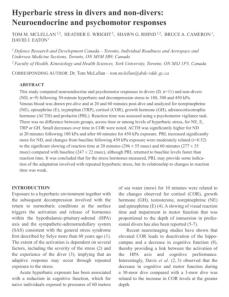

It is generally accepted that the incidence of
decompression sickness (DCS) from hyperbaric exposures
is low when few or no bubbles are present in the
circulation. To date, no data are available on the influence
of in-water oxygen breathing on bubble formation
following a provocative dive in man. The purpose of this
study was to compare the effect of post-dive hyperbaric
versus normobarc oxygen breathing (NOB) on venous
circulating bubbles.
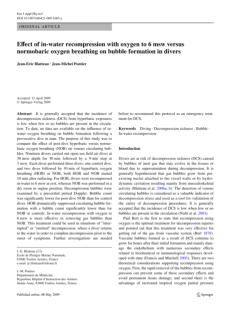

Oxygen pre-breathing is routinely employed as a
protective measure to reduce the incidence of altitude
decompression sickness in aviators and astronauts, but the
effectiveness of normobaric oxygen before hyperbaric
exposure has not been well explored. The objective of this
study was to evaluate the effect of 30-min normobaric
oxygen (O2) breathing before diving upon bubble
formation in recreational divers.
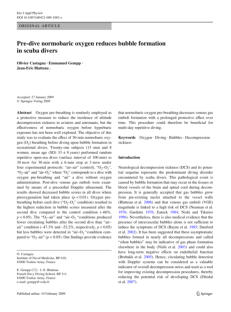

Man-testing at the Navy Experimental Diving Unit
(NEDU) of the Thalmann Algorithm VVal-18 air no-stop
limits at 130, 150, and 190 feet of seawater resulted in
incidents of severe central nervous system decompression
sickness. A logistic model of the probability of CNS DCS in
air no-stop dives from the recent NEDU man-testing and
the USN primary N2-O2, data set was developed and
used to produce a set of iso-risk air no-stop limits. A new
parameter set (VVal-76) for the Thalmann Algorithm that
produces air no-stop limits was developed.
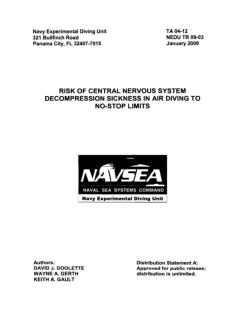

Scuba divers are at risk of decompression sickness due to
the excessive formation of gas bubbles in blood and
tissues following ascent, with potentially subsequent
neurological injuries. Since
nonprovocative dive profiles are no guarantor of
protection against this disease, novel means are required
for its prevention including predive procedures that could
induce more resistance to decompression stress. In this
article, the authors review the recent studies describing
the promising preconditioning methods that might
operate on the attenuation of bubble formation believed
to reduce the occurrence of decompression sickness.
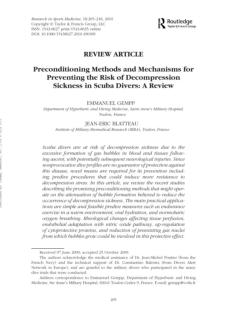

Authors: Marko Ljubkovic, Jasna Marinovic, Ante Obad,
Toni Breskovic, Svein E. Gaustad, and Zeljko Dujic.
SCUBA diving is associated with the generation of gas
emboli due to gas release from the supersaturated tissues
during decompression. Gas emboli arise mostly on the
venous side of the circulation, and they are usually
eliminated as they pass through the lung vessels.
Arterialization of venous gas emboli (VGE) is seldom
reported, and it is potentially related to neurological
damage and the development of decompression sickness.
The goal of the present study was to evaluate the
generation of VGE in a group of divers using a mixture of
compressed oxygen, helium, and nitrogen (trimix) and to
probe for their potential appearance in the arterial
circulation.
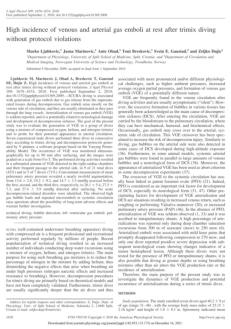

Authors: Philip P. Foster, Bruce D. Butler
This review discusses topics about the relationship
between muscle activity, decompression, and
microgravity. It also provides, in the context of altitude
decompression, an overview of the role of
denitrogenation, metabolic gases, gas micronuclei,
stabilization of bubbles, biochemical pathways activated
by bubbles, nitric oxide, oxygen, anthropometric or
physiological variables, Doppler-detectable bubbles, and
potential arterialization of bubbles.
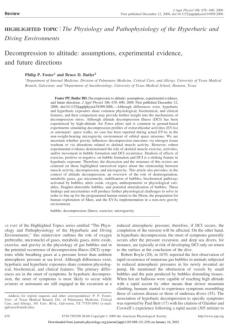

Authors: Emmanuel Gempp & Jean-Eric Blatteau
This study was designed to determine the recompression
strategy and the potential risk factors associated with the
development of severe diving-related spinal cord
decompression sickness (DCS).
Sixty-three injured recreational divers presenting with
symptoms of spinal involvement were retrospectively
included. Diving information, symptom latency after dive
completion, and time interval between symptom onset
and hyperbaric treatment were studied. The severity of
spinal cord DCS was rated numerically for both the acute
event and one month later. Initial recompression
treatment at 2.8 atmosphere absolute (ATA) with 100%
oxygen-breathing or deeper recompression at 4
atmospheres absolute with nitrogen-oxygen or helium-
oxygen breathing mixture was also noted.
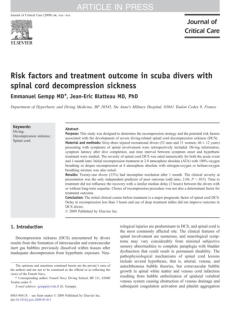

Authors: T. Randsoe, and O. Hyldegaard
The authors of this study hypothesize that the combined
effect of normobaric oxygen breathing and intravascular
PFC infusion could lead to either enhanced extravascular
bubble growth on decompression due to the increased
oxygen supply or that perfluorocarbon infusion could lead
to a faster bubble elimination due to the increased
solubility and transport capacity in blood for nitrogen
causing faster nitrogen tissue desaturation.

Authors: Peter Germonpré, Jean-Michel Pontier,
Emmanuel Gempp, Jean-Eric Blatteau, Stefaan Deneweth,
Pierre Lafère, Alessandro Marroni, and Costantino Balestra.
The preconditioning of divers to reduce post-dive de-
compression sickness (DCS) has gained increased interest
in diving medical research over the last few years. The
beneficial effects of physical exercise, oxygen breathing,
hyperbaric exposure, heat exposure, hyper-hydration, or
nitroglycerin administration before the dive are only a few
examples of ongoing research. In this work, the authors
investigated the effects of pre-dive whole-body vibration
on post-dive bubble formation.
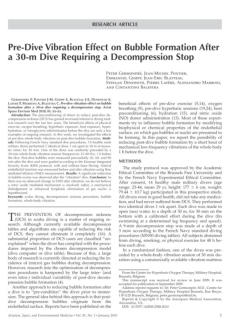

Authors: Gerardo Bosco, Zhong-jin Yang, Guglielmo Di
Tano, Enrico M. Camporesi, Fabio Faralli, Fabio Savini,
Angelo Landolfi, Christian Doria, and Giorgio Fanò.
The effect of in-water oxygen prebreathing at different
depths on decompression-induced bubble formation and
platelet activation in scuba divers was evaluated. Six
volunteers participated in four diving protocols, with 2 wk
of recovery between dives.
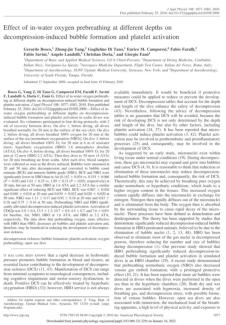

Authors: Jean-Eric Blatteau, E. Gempp, O. Simon, M.
Coulange, B. Delafosse, V. Souday, G. Cochard, J. Arvieux,
A. Henckes, P. Lafere, P. Germonpre, J.-M. Lapoussiere, M.
Hugon, P. Constantin, A. Barthelemy.
This study aims to determine the potential risk factors
associated with the development of severe diving-related
spinal cord decompression sickness (DCS).
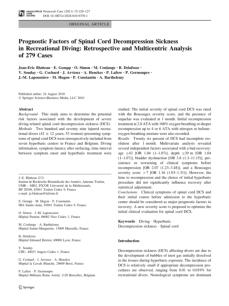

Authors: Michael H. Bennett, MD, Fanzca, Jan P. Lehm,
Simon J. Mitchel, Ph.D, Fanzca, Jason Wasiak.
Recompression is the universally accepted standard for
the treatment of decompression illness (DCI). When
recompression is delayed, a number of strategies have
been suggested to improve the outcome. The authors
examined the effectiveness and safety of both
recompression and adjunctive therapies in DCI treatment.
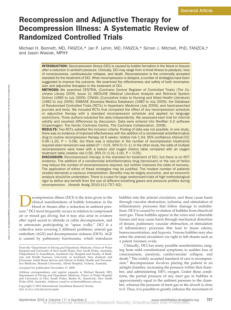

Authors: T G Anthony, N A Wright, M A Evans (QinetiQ)
This UK HSE document is a review of diver noise exposure
encompassing diver hearing, noise sources, exposure
levels, and control measures.
This document, which takes into account other studies
available in our database can be considered one of the
most appropriate and easiest to implement. It can be
downloaded from our database by clicking on the
picture, or from the UK HSE website through this link:
https://www.hse.gov.uk/research/rrpdf/rr735.pdf
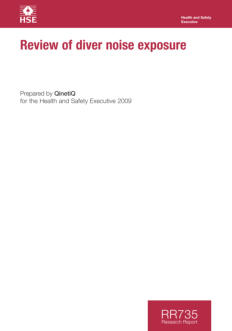

Authors:
Olivier Castagna, Jeanick Brisswalter, Nicolas Vallee, Jean-
Eric Blatteau
Previous studies have observed that a single bout of
exercise can reduce the formation of circulating bubbles
on decompression, but, according to different authors,
several hours of delay were considered necessary
between the end of exercise and the beginning of the
dive.
The objective of this study was to evaluate the effect of a
single bout of exercise taken immediately before a dive on
bubble formation.
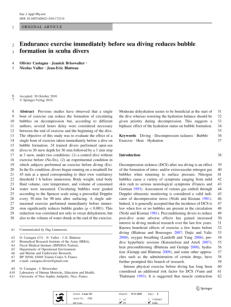

Authors: Pierre Lafere, Ciostantino Balestra, Walker
Hemelryck, Nicole Donda, Ahmed Sakr, Adel
Taher, & Peter Germonpre
Many divers report less fatigue following dives breathing
enriched air nitrox than breathing air. A reduction of post
fatigue with nitrox would suggest a pathological origin,
possibly the presence of asymptomatic nitrogen bubbles
in the body after a dive. The authors studied fatigue in
219 healthy divers performing either air or nitrox 32% O2
dives to 21.2 msw for 43.3 min in tropical waters. The
divers were assessed before the dive and 30 to 60
minutes after surfacing.
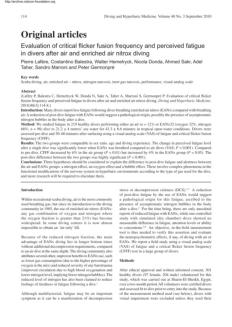

Authors: BR Bollinger, JC Wilbur, TG Donoghue, SD
Phillips, DA Knaus, PJ Magari, DL Avarenga, JC
Buckey
Indirect evidence suggests that microbubbles that
normally exist in tissue may play a key role in
decompression sickness (DCS). Their sizes and locations
are unknown. Dual-frequency ultrasound (DFU)
exploits bubble resonance to detect bubbles over a wide
range and could potentially detect stationary tissue
microbubbles. To test this capability, DFU was used to
detect stationary microbubbles of known size (2-3 µm
mean diameter) over a range of ultrasound pressures and
microbubble concentrations
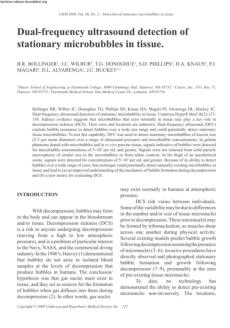

Authors: J. C. Wilbur, S. D. Phillips, T. G. Donoghue, D. L.
Alvarenga, D. A. Knaus, P. J. Magari, and J. C.
Buckey
Exercise may produce micro-nuclei in tissue, which could
serve as nucleation sites for bubbles during subsequent
decompression stress. These micronuclei have never been
directly detected in humans. Dual-frequency ultrasound
(DFU) is a resonance-based ultrasound technique capable
of detecting and sizing small stationary bubbles. The
authors surveyed for bubbles in the legs of six normal
human subjects (ages 28–52 yr) after exercise using DFU
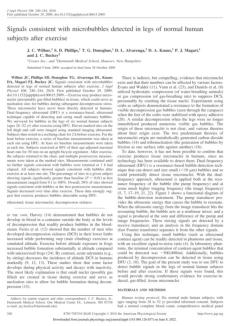

Author: Saul Goldman
Thermodynamic expressions are derived for the system
relative Gibbs free energy and the relative Gibbs free
energy per bubble for all possible equilibrium bubble
states that can form in a soft, slightly rigid material, initially
supersaturated with a dissolved inert gas N2 . While the
thermodynamic manipulations are exact, the final
expressions are approximate due to an approximation
made in deriving the expression for the elastic free energy
of a soft material containing more than a single bubble.
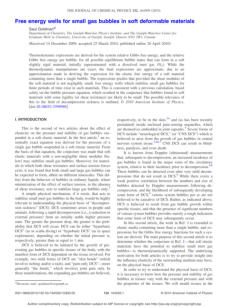

Authors: Stephen R. Thom, Ming Yang, Veena M. Bhopale,
Shaohui Huang, and Tatyana N. Milovanova.
Progressive elevations in circulating annexin V-coated
microparticles
(MPs) derived from leukocytes, erythrocytes, platelets, and
endothelial cells are found in mice subjected to increasing
decompression stresses. Individual MPs exhibit surface
markers from multiple cells.
MPs expressing platelet surface markers, in particular,
interact with circulating neutrophils, causing them to
degranulate and leading to further MP production.
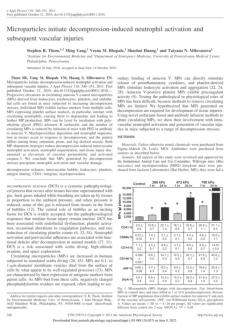

Authors: R. E. Moon, A. D. Cherry, B. W. Stolp, and E. M.
Camporesi
Diving-related pulmonary effects are due mostly to
increased gas density, immersion-related increase in
pulmonary blood volume, and (usually) a higher inspired
PO2. Higher gas density produces an increase in airways
resistance and work of breathing, and a reduced
maximum breathing capacity. An additional mechanical
load is due to immersion, which can impose a static trans-
respiratory pressure load as well as a decrease in
pulmonary compliance. The combination of resistive and
elastic loads is largely responsible for the reduction in
ventilation during underwater exercise.
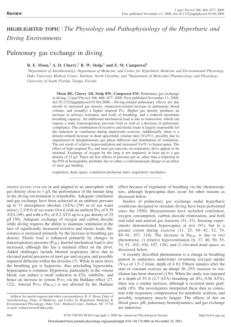
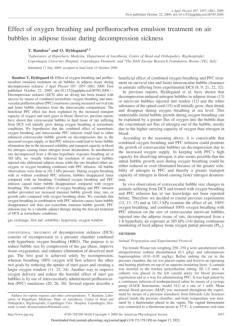

Authors: V. Lobo, A. Patil, A. Phatak, N. Chandra
Last research about decompresion illness and the use of
oxygen highlight the role of free radicals.
The body generates free radicals, reactive oxygen species,
and reactive nitrogen species by various endogenous
systems, exposure to different physiochemical conditions,
or pathological states. A balance between free radicals
and antioxidants is necessary for proper physiological
function. Suppose free radicals overwhelm the body’s
ability to regulate them, and a condition known as
oxidative stress ensues. Free radicals thus adversely alter
lipids, proteins, and DNA and trigger many human
diseases.
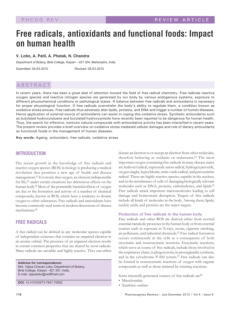

Authors: Agnieszka Ciarka , Vi Doan , Sonia Velez-Roa,
Robert Naeije, and Philippe van de Borne
The authors of this study investigated the prognostic
significance of muscle sympathetic nervous system activity
in pulmonary arterial hypertension.
This is another purely medical document whose
conclusions can be used to understand the effect of
oxygen during diving operations.
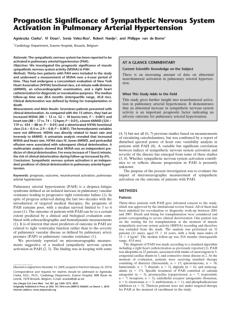

Authors:
Dionne F. Peacher, Shelly R. H. Pecorella, John J.
Freiberger, Michael J. Natoli, Eric A. Schinazi, P. Owen
Doar, Albert E. Boso, Aaron J. Walker, Matthew Gill,
Dawn Kernagis, Donna Uguccioni, and Richard E. Moon
Based on the fact that previous studies revealed a
progressive increase in ventilation during prolonged
immersed exercise, the authors hypothesized that this
increase occurs because of the development of
metabolic acidosis with a concomitant rise in mean
pulmonary artery pressure and that hyperoxia
attenuates this increase.
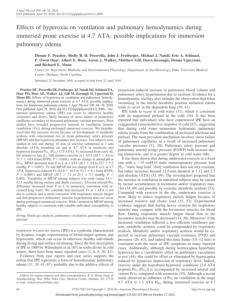

Authors: Wayne A. Gerth
The Thalmann Decompression Algorithm (EL-DCA) was
developed using VVal-18 and HVal-21. The original EL-
DCA was extensively modified to develop MK 16 MOD 1
N2 -O2 and He-O2 decompression tables and
Submarine Rescue and Diving Recompression System
Operator/Tender decompression tables. The EL-DCA was
further modified and used with a modified VVal-18
parameter set, designated VVal-18M, to produce an
integrated set of air diving decompression tables for
Revision 6 of the U.S. Navy Diving Manual.
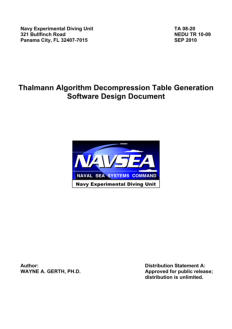

Authors: Cara Connolly, Alex Munnoch, & Fiona Hogg
High-pressure water jets (HPWJ) have diverse industrial
use. With pressures up to 100,000 psi (power rce/sq.inch)
generated in a narrow water jet, they can be used to
mine granite and cut steel. Features of soft tissue injuries
caused by high-pressure water jets have
been described by Tejero-Trujeque: The surface wound of
a HPWJ injury may not reflect the extensive tissue damage
beneath, the wound may be widely contaminated by
materials driven into the wound, there is a potential for
progressive oedema and inflammation, and unusual
infections may occur due to micro-organisms in the water
source.
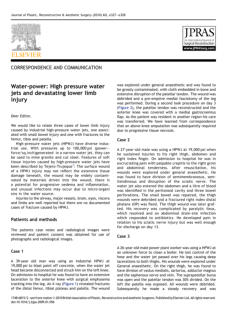

Authors: Le Feng, Christian R. Gutvik, Tor A. Johansen,
Dan Sui
This paper is based on a comprehensive dynamic
mathematical model of vascular bubble formation and
growth during and after decompression from a dive. The
model describes the underlying relationship between
Venous Gas Emboli (VGE) and severe Decompression
Sickness (DCS) risk. Using the Copernicus model, the
diving decompression problem can be formulated as a
nonlinear optimal control problem, where the objective is
to minimize the total ascend time subject to constraints on
the maximum number of bubbles in the pulmonary artery
(also referred to as the decompression stress).
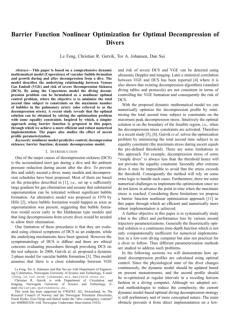


Authors:
Harold Rea, Sue McAuley, Lata Jayaram, Jeffrey Garrett,
Hans Hockey, Louanne Storey, Glenis O’Donnell, Lynne
Haru, Matthew Payton, Kevin O’Donnell
Persistent airway inflammation with mucus retention in
patients with chronic airway disorders such as COPD and
bronchiectasis may lead to frequent exacerbations,
reduced lung function, and poor quality of life. This study
investigates whether long-term humidification therapy
with high-flow, fully humidified air at 37 °C through nasal
cannulae can improve these clinical outcomes in this
group of patients. On the diving side, this study is to be
linked to the quality of breathing gases and conditions
resulting from airway inflammation.
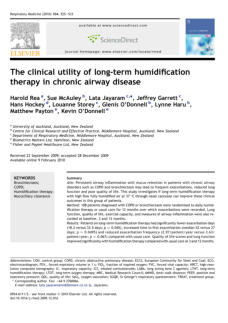

Authors: Mario Alaimo, Giuseppe Aiello, Eduardo Marino,
Leila Zummo, Francesco Cappello
The authors report a case of a 41-year-old expert diver
who, after a series of brath hold dives (60 to 80s/dive at
20 to 24m of depth for 5 consecutive hours), experienced
vertigo, ringing in the left ear, and confusion, followed by
right arm paresthesia trailed by right hemi-paresis after a
few minutes. After <60 minutes from the emergence of
these symptoms, he was admitted to the emergency unit
of our hospital with less severe clinical features, presenting
only confusion and paresthesia of the right hand.


Authors: J H Breedjik, G J G M Van Der Putten, L M
Schrier, W Sterk
Hyperbaric work was conducted for constructing an
underground tramway in the Netherlands. A total of
11,647 exposures were conducted in 41,957 hours. For
these working conditions, specifically developed
decompression tables were used. Fifteen workers were
submitted to Doppler monitoring after caisson work at a
depth at I 2 msw. Measurements were done according to
the Canadian DCIEM protocol. For bubble grading, the
Kisman-Masurel 12-point ordinal scale (0-IV) was used.
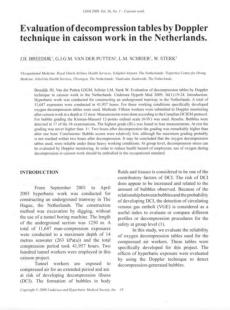

Authors: Frederik Kragerud Goplen, Marit Grønning,
Torbjørn Aasen, and Stein Helge Glad Nordahl
Divers occasionally suffer vestibular injuries due to
barotrauma or decompression illness (DCI). Acute cases
are typically identified by a combination of vertigo,
nausea, and vomiting, with a tendency to fall to the
injured side and nystagmus to the contralateral side. The
loss of peripheral vestibular function may be permanent,
but in spite of this, there is often nearly complete
symptomatic recovery after weeks to months due to
central vestibular compensation.
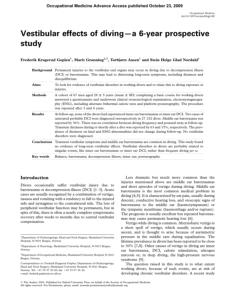

Authors: Venkata M. lla, Nagendra Natarajan, Manu
Kaushik, Rugmini Warrier, Chandra K. Nair
Effort thrombosis, or Paget-Schroetter Syndrome, refers to
axillary-subclavian vein thrombosis associated with
strenuous and repetitive activity of the upper extremities.
Anatomical abnormalities at the thoracic outlet and
repetitive trauma to the endothelium of the subclavian
vein are key factors in its initiation and progression. The
role of hereditary and acquired thrombophilias is unclear.
The pathogenesis of effort thrombosis is thus distinct from
other venous thromboembolic disorders.
Doppler ultrasonography is the preferred initial test, while
contrast venography remains the gold standard for
diagnosis.
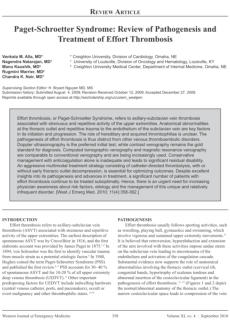

Authors: Vanessa Carli Bones Silla, Elaine Cristina de
Oliveira Sans and Carla Forte Maiolino Molento
Animal use in research is an issue of increasing ethical
concern. The objective of this work was to investigate
animal usage in research described in the papers
appearing in 18 journals published in the State of Paraná
in 2006. The fields used in the bibliographic sampling
were agrarian science, biological science, biological and
health science, environmental science, food technology,
and health science. Of the 865 papers analyzed, 41%
involved the use of animals, totaling a total of 3,497,653
animals, of which 216,223 were vertebrates.
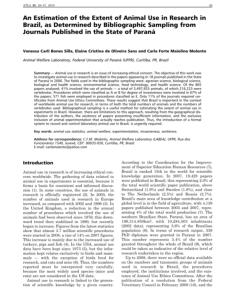

Author: Gezina T.M.L. Oei, Nina C. Weber, Markus W.
Hollmann, Benedikt Preckel
This review covers the cellular effects of helium, which
research in cardiac and neuronal tissue has shown that,
besides volatile anesthetics and xenon, the non-anesthetic
noble gas helium also reduces ischemic pre-perfusion
damage. It shows that using this gas may lead to new
clinical strategies for tissue salvage in ischemia-reperfusion
situations, both within and outside the perioperative
setting. This should be considered when designing
decompression tables.
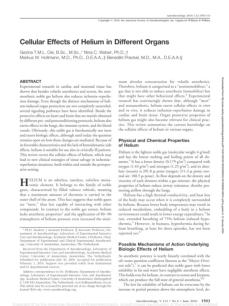

Click on the octopus
to return to the top
of the page



Authors:
Richard D. Vann, Petar J. Denoble, Laurens E. Howle, Paul
W. Weber, John J. Freiberger, & Carl F. Pieper
The authors examined how decompression illness is
categorized. Instead of broad classifications like Type 1 and
Type 2, they now focus on specific symptoms. They use
scoring systems for symptoms, check how they relate to
lingering effects, and use statistical methods to find
patterns over time. This method handles various types of
data and incomplete cases, aiding in the comprehension
of the most effective treatments and the severity of the
illness might be.
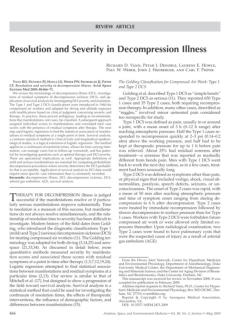
Authors: Jean-Michel Pontier, François Guerrero, and
Olivier Castagna
This study examined whether intensive scuba dive training
would reduce bubble formation and modulate
endothelial function as shown by skin circulation.
The results highlight that repeated scuba dives and
regular physical exercise activity reduce bubble formation
and probably protect against DCS risk.
Although this phenomenon has been observed for
decades, the mechanism remains complex, and the results
cannot elucidate the effects of physical exercise and NO
production. Bubble formation could activate the stress
response, which could be the basis for diving
acclimatization.
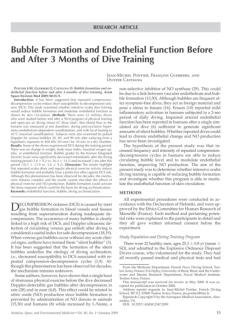

Authors: Frédéric Lemaître, Daniel Carturan, Claire Tourny
Chollet, and Bernard Gardette
Doppler ultrasonic detection of circulating venous bubbles
after a scuba dive is a useful indicator of decompression
safety in adults, as there is a documented relationship
between bubbles and the risk of decompression sickness.
The aim of this study was to determine whether bubbles
would be detected in children who performed a single
dive without modifying their diving habits. The results
showed that venous bubbles were not detected in
children during a typical shallow diving session.
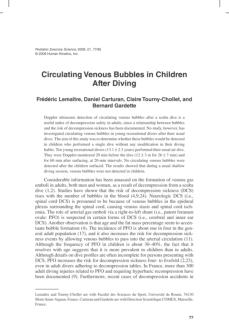

Authors: P David Cooper, Corry Van den Broek, David R
Smart, Ron Y Nishi and David Eastman
To evaluate the decompression stress experienced by
hyperbaric nursing and medical staff and gather
demographic insights, Doppler assessments were
conducted on 28 personnel at 20-minute intervals for up
to 120 minutes after exposure. The results showed that
68% of the exposures were classified with a low Kisman-
Masurel grade, 22% with an intermediate grade, and 10%
with a high grade. Trends toward higher bubble grades
were observed among female staff members and with
increasing age, weight, and exposure frequency. No
cases of clinical decompression sickness were reported.
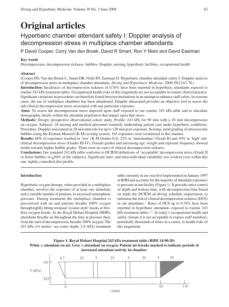

Authors:
Martin DJ Sayer, John AS Ross and Colin M Wilson
Researchers analyzed two datasets from Scotland to
examine trends in treating diving-related illnesses and the
impact of initial treatment on divers' conditions upon
referral and discharge. The study found that 90-92% of
divers received standard or modified Royal Navy
Treatment Table 62 or US Navy Table 6 as their primary
treatment. About 32% of divers were in severe condition
upon admission, but only 4% remained in severe
condition at discharge. The analysis suggests that using
shorter and shallower treatment tables as the initial
treatment could result in worse outcomes.
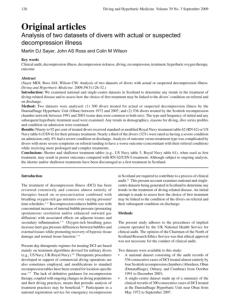

Authors: Frederic Lemaitre, Andreas Falhman, Bernard
Gardette, & Kiyotaka Kohshi
Although it is commonly believed that the risk of
decompression sickness is almost non-existent during a
single breath-hold dive, engaging in multiple breath-hold
dives with brief intervals on the surface could increase the
risk for both humans and marine mammals. For instance,
neurological issues and non-pathogenic bubbles have
been observed in breath-hold divers. Marine mammals,
which may have naturally higher nitrogen levels, might
face risks when altering their diving behaviors.
Adaptations, such as pulmonary shunts or lung collapse in
deep dives, may help mitigate these risks.
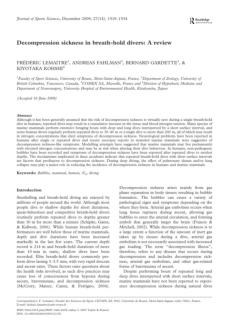

Authors: Chong Si Jack, Liang Weihao, Kim Soo Joang
and Kang Wee Lee
The growing popularity of recreational diving has led to
an increase in diving-related injuries and a higher
demand for specialized medical treatment. In response,
Singapore General Hospital (SGH) has established the
new Hyperbaric and Diving Medicine Centre,
strengthening collaboration with the Singapore Navy
Medical Service (NMS). This partnership, cemented by a
recent Memorandum of Understanding, utilizes NMS's
expertise and SGH's resources to advance research,
training, and the formal recognition of diving and
hyperbaric medicine as a medical subspecialty.
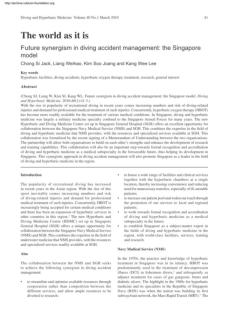

Authors: Rohit Verma
This study discusses a case of musculoskeletal DCI post-
saturation diving, underscoring the unpredictable nature
of DCI and its impact on an individual's fitness for diving.

Authors: Marko Ljubkovic, Zeljko Dujic, Andreas
Mollerlokken, Darija Bakovic, Ante Obad, Toni
Brekovic, and Alf O. Brubakk
The study examined the occurrence and frequency of
venous gas emboli (VGE) after no-stop air dives. Twelve
divers performed six dives each under standard no-
decompression procedures and were monitored for VGE
via ultrasound for 120 minutes post-dive. The results
showed a high production of gas bubbles, primarily
grade 4, with VGE detected in the systemic circulation of
41.7% of divers, particularly when significant bubble
presence was noted in the heart's right valve. Despite the
frequent detection of VGE, no decompression-related
health issues were observed.
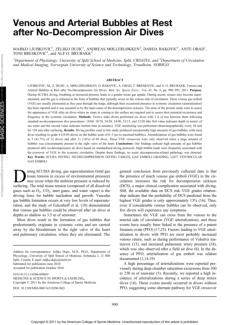
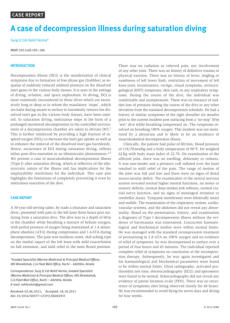




Authors:
Siri Waage, Bente Elisabeth Moen, Ståle Pallesen, Hege R.
Eriksen, Holger Ursin, Torbjørn Åkerstedt, Bjørn Bjorvatn
The purpose of this document is to provide information
about the affiliations of various departments and research
centers associated with the University of Bergen in
Norway and the Karolinska Institutet in Sweden. It lists the
specific departments and research centers, along with
their locations, indicating a collaborative or multi-
institutional context.
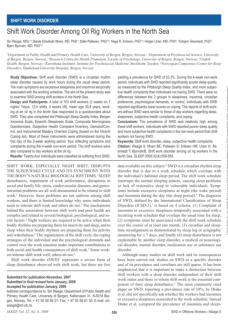
Authors: Ulrik Wisloff, Oyvind Ellingsen, and Ole J. Kemi
This document presents and supports the hypothesis that
high-intensity aerobic interval training leads to more
significant beneficial heart adaptations compared to low-
to-moderate exercise intensity. The text also aims to discuss
the cellular and molecular mechanisms underlying
myocardial adaptation to exercise training, referencing
recent epidemiological, experimental, and clinical studies
to support the hypothesis.


Authors:
Yasushi Mio, Yon Hee Shim, Ebony Richards, Zeljko J.
Bosnjak, Paul S. Pagel, & Martin Bienengraebe
The paper presents a scientific study investigating the
mechanisms behind xenon-induced cardioprotection
during ischemia/reperfusion injury in the heart. The study
aims to test the hypothesis that xenon protects the heart
by activating prosurvival signaling kinases that target
mitochondria. The text details the methods, results, and
conclusions of the experiment conducted on male Wistar
rats, highlighting the significant findings that support the
hypothesis.


Authors:
Asna Marinovic, Marko Ljubkovic, Ante Obad, Darija
Bakovic, Toni Breskovic, and Zeljko Dujic
The purpose of this document is to present the results of a
scientific study investigating the cardiovascular effects of
trimix dives compared to air dives. The purpose of the
study was to determine how these dives affect
cardiovascular function, with a specific focus on left
ventricular systolic function and pulmonary artery pressure,
and whether repeated dives over consecutive days have
cumulative effects. The results showed that both trimix and
air dives significantly affected cardiovascular function, but
no cumulative effects or signs of acclimatization were
observed.

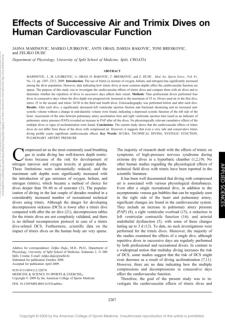

Authors:
Loic Doeuvre, Laurent Plawinski, Florence Toti and
Eduardo Angles-Cano
This paper aims to inform the reader about the role and
significance of microparticles (MPS) in various
physiological and pathological contexts. It explains how
MPS are formed, their sources, and their procoagulant
activity, which is linked to several diseases. Additionally,
the text highlights the emerging role of MPS as
biomarkers for tissue activation or damage, particularly in
neurovascular conditions, and suggests their potential use
in disease prediction, diagnosis, prognosis, and follow-up.

Authors:
Eliana Lucchinetti, Johannes Wacker, Christian Maurer,
Marius Keel, Luc Harter, Kathrin Zaugg, Michael Zaugg
This paper presents the findings of a scientific study that
investigated the effects of helium inhalation on
endothelial function and inflammatory markers in humans
following ischemia-reperfusion of the forearm. The study
aimed to determine whether helium could provide
protection against postocclusive endothelial dysfunction.
The results showed that while helium inhalation reduced
certain inflammatory and procoagulant markers, it did not
improve endothelial function as measured by hyperemic
reactions.
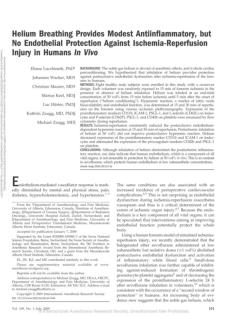

Authors: Hideki Tamaki, kiyotaka kohshi, Shuichi sajima,
junichiro Takeyama, Takashi nakamura, Hideo
ando, Tatsuya Ishitake
This study reports a medical case study of a Japanese
male professional breath-hold diver who developed
neurological disorders, including sensory numbness and
double vision, after repetitive deep dives. The report
highlights the potential risks and dangers associated with
repetitive deep breath-hold diving with short surface
intervals, suggesting that such activities can lead to serious
and possibly fatal health issues, such as cerebral infarcts.
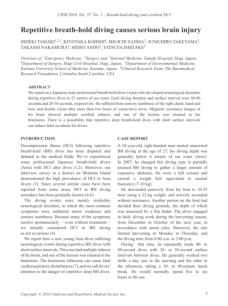

Authors: John A. S. Ross, Jennifer I. Macdiarmid, Finlay D.
Dick and Stephen J. Watt
This document presents the findings of a study comparing
hearing loss between professional divers and offshore
workers. The study aims to determine whether hearing
loss symptoms reflect physical disorders and evaluate the
effectiveness of total threshold shift assessment for
detecting noise-induced hearing loss (NIHL). The text
details the study's methodology, results, and conclusions,
highlighting that divers experience more NIHL than
offshore workers and suggesting that current guidelines
for assessing total threshold shifts may be inadequate.
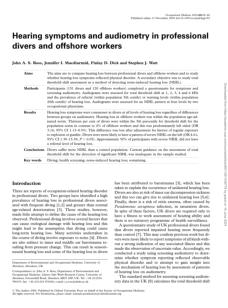

Authors: Kim-Vdar Rasdal, Astrid Hjede, Andrea
Mollerloken, Nina Lundset, & Alf Ottar Brubakk
This document presents the findings of a scientific study
that investigated the effects of decompression on arterial
endothelial function in rats. The study aimed to determine
whether decompression without visible bubble formation,
as detected by ultrasound, had any impact on arterial
endothelial function. The results indicated that
decompression led to significant endothelial dysfunction
in the aorta, even in the absence of visible venous
bubbles. The study also concluded that there was no
evidence of blood-brain barrier damage or brain edema
in the rats.
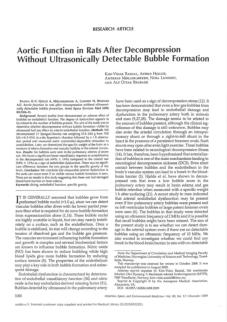

Authors:
Philip D Loetsche, Jan Rossaint, Rolf Rossaint , Joachim
Weis , Michael Fries, Astrid Fahlenkamp, Yu-Mi Ryang,
Oliver Grottke, and Mark Coburn
This study presents a scientific study that investigates the
neuroprotective potential of the noble gas argon. The
study aims to determine whether argon can protect brain
cells from damage caused by traumatic brain injury and
cerebral ischemia, similar to the effects observed with
other noble gases like xenon and helium. The text outlines
the methods used, the results obtained, and concludes
that argon has shown neuroprotective effects in vitro,
warranting further in vivo animal research.
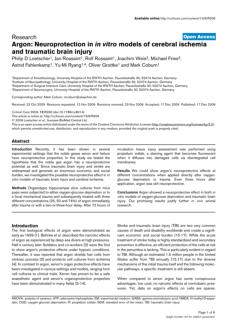

Authors: Jan Krog, Else K. Tønnesen, Claus F. Jepsen, Erik
Parner, Kåre Segadal, Arvid Hope, Rune J. Ulvik,
and Marianne E. Hokland
This text presents a scientific study that investigates the
effects of hyperbaric exposure on the human immune
system, specifically focusing on the distribution and activity
of natural killer (NK) cells. The study aims to determine
whether monitoring specific lymphocyte subsets,
including T- and NK-cell subsets, can serve as biomarkers
for hyperbaric stress. The text details the methods used,
including the isolation of peripheral blood mononuclear
cells and the use of 4-color flow cytometry to delineate
lymphocyte subpopulations.
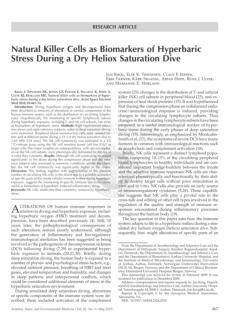

Author: Naoshi Kakitsuba
This study reviews and provides information on thermal
problems and thermal comfort zones in hyperbaric
environments, mainly focusing on the challenges faced by
divers in hyperbaric helium-oxygen atmospheres. The
paper discusses the effects of helium's high thermal
conductivity and increased pressure on heat exchange
between divers and their environment and presents
findings from studies on clothing insulation and
permeability under different pressures. The ultimate goal is
to demonstrate the comfort range of ambient
temperatures at increased barometric pressures.
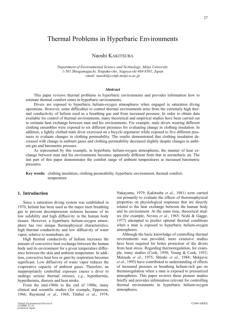

Author: John W. Castellani, Michael N. Sawka, David W.
DeGroot, Andrew J. Young
The purpose of this document is to inform readers about
the condition known as "thermoregulatory fatigue," which
affects individuals engaged in prolonged, physically
demanding cold-weather activities. The text explains the
physiological responses to cold exposure, such as
shivering and peripheral vasoconstriction, and discusses
how these responses can be impaired by prolonged or
repeated cold exposure and sustained physical exertion.
The text also highlights the potential mechanisms behind
this impairment and the increased risk of hypothermia
associated with thermoregulatory fatigue.
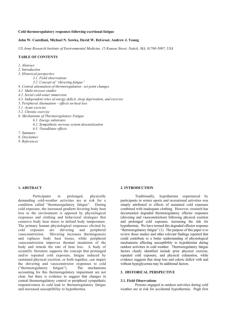

Authors: Mayumi Kajimura, Ryo Fukuda, Ryon M. Bateman,
Takehiro Yamamoto, and Makoto Suematsu
This document reviews and discusses the physiological
roles and interactions of the body's biological gases (O2,
CO, NO, and H2S). It highlights the significance of these
gases as signaling molecules, their interactions with heme-
based proteins, and their effects on mitochondrial
functions such as respiration, biogenesis, and suspended
animation. The review addresses key issues in "gas
biology," including effective tissue concentrations and the
proximity between gas-producing and gas-
receptor/sensor sites.
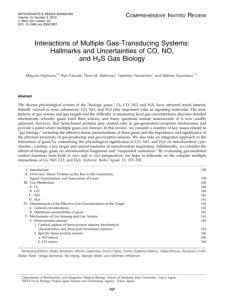

Authors: Ivan T. Demchenko, Yu Zhilyaev, A. N. Moskvin,
Claude A. Piantadosi, and Barry W. Allen
This text intends to present scientific research findings on
the effects of hyperbaric oxygen (HBO2) exposure at high
pressures on the pulmonary and cardiovascular systems.
The text aims to explain the mechanisms behind acute
pulmonary injury caused by HBO2, mainly focusing on
the role of autonomic nervous system activation and its
impact on pulmonary vascular pressure and heart
function. The research involves experiments on rats to
measure various physiological parameters and to test the
hypothesis that HBO2 exposure leads to significant
sympathetic outflow, resulting in pulmonary and
cardiovascular complications.


Authors: Jon O. Lundberg, Mattias Carlstrom, Filip J.
Larsen, and Eddie Weitzberg
This document informs and highlights the emerging
understanding of the health benefits of inorganic nitrate,
particularly from dietary sources such as vegetables. It
discusses the potential mechanisms through which nitrate
exerts its effects, including the generation of nitric oxide
and other reactive nitrogen oxides, and its impact on
cardiovascular health, exercise performance, and oxidative
stress. The text aims to convey the significance of nitrate in
reducing blood pressure, protecting against
cardiovascular disorders, and potentially contributing to
the beneficial health effects of a vegetable-rich diet.
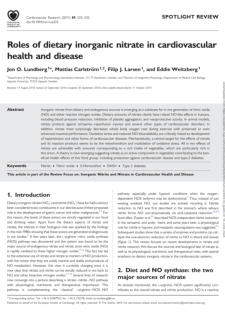

Authors: Ivan T. Demchenko, S. Yu Zhilyaev, A.N. Moskvin,
Claude A. Piantadosi, and Barry W. Allen
This study aims to elucidate the mechanisms behind acute
pulmonary injury caused by HBO2, particularly focusing
on the role of autonomic nervous system activity and
hemodynamic changes. The research involves
experiments on rats to measure various physiological
parameters and test the hypothesis that extreme HBO2
exposure leads to significant pulmonary vascular pressure
increases and subsequent barotrauma. The findings
suggest that these effects are due to central sympathetic
excitation and catecholamine release, which disrupt the
balance in the autonomic nervous system.
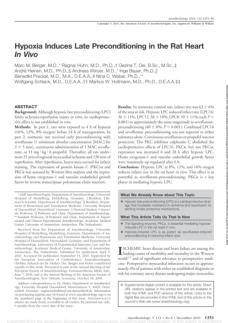
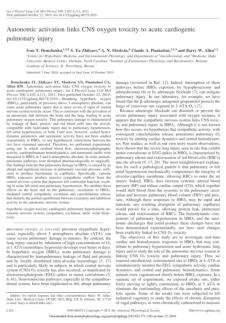

Authors:
Marc M. Berger, Ragnar Huhn, Gezina T. Oei, Andre´
Heinen, Andreas Winzer, Inge Bauer, Benedikt Preckel,
Nina C. Weber, Wolfgang Schlack, Markus W. Hollmann
This scientific study investigates the cardioprotective effects
of hypoxic late preconditioning (LPC) in vivo, specifically in
rat hearts. The study aims to determine whether hypoxic
LPC can reduce ischemia-reperfusion injury and compares
its effectiveness to sevoflurane preconditioning. The text
details the methods used, the results obtained, and the
conclusion that hypoxic LPC significantly reduces infarct
size, with protein kinase C (PKC) playing a key role in this
protective effect.
